29 Nov Epoxy Terrazzo: A Proven Flooring Solution
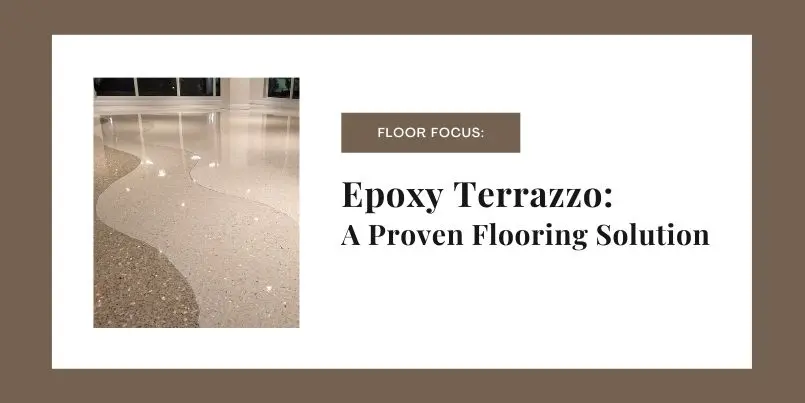
Epoxy Terrazzo: A Proven Flooring Solutions
Epoxy terrazzo is a cost-effective, sustainable flooring system that can be installed in new construction or existing buildings. For over a century, terrazzo has been a proven flooring solution for commercial applications. It hits many of the checkmarks many architects and interior designers seeks when selecting a flooring material including:
- a durable and resilient surface with long lifecycles
- a versatile finish with design options for colors and patterns
- materials that are environmentally friendly and suitable for green construction.
- a floor that is easy to maintain
Terrazzo has become well-known over the years as a logical and practical flooring system for new schools, airports, and hospitals, that yields cost savings for building owners. It has even been adapted for use in historical buildings and renovations. Rather than demolish and remove the existing flooring system, epoxy terrazzo can be applied depending on the floor conditions. If epoxy terrazzo can be poured over the existing floor, it offers an innovative way and cost-effective way to bring new life to a building’s flooring system.
Original “Green” Flooring System
Terrazzo has been installed in the United States since the early 1900s. Evidence from case studies has demonstrated that those floors remain in good conditions today. With proper maintenance techniques, it has been said that terrazzo flooring can last 100 years or more. Other flooring systems don’t come close to matching this lifecycle. As a result, today architects and interior designers are finding versatile ways to include the material into their building designs.
Terrazzo has a rich history dating back to the 16th century. Through the years, there have been different systems that have been installed, each with its unique characteristics and methods. Advancements in technology and research by manufacturers also continue to support terrazzo as a superior flooring product.
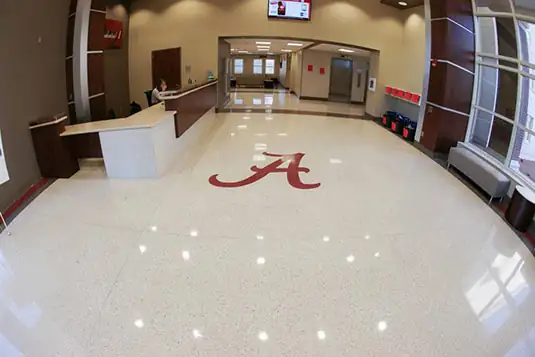
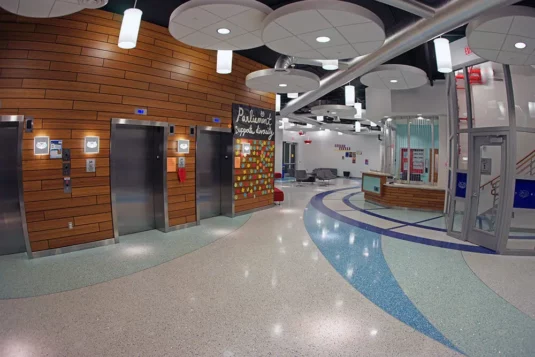
History
According to the NTMA (National Terrazzo and Mosaic Association), epoxy terrazzo accounts for 95% of current installations. But did you know that epoxy terrazzo was only formed during the 1970s?
Terrazzo was invented during the 16th century. Credit is often given to Italian craftsmen, while some archeologists even claim it predates back to ancient Turkish civilizations around 10,000 B.C.E. At the time of its invention, craftsmen reused marble fragments to build terraces around their living quarters. Hence, the origins of the word terrazzo mean “terrace.” Traditional terrazzo was cement-based, combining marble or granite chips and then ground and polished.
Italian immigrants spread the trade into Western Civilization around the late 1800s. During the Art Deco Movement of the 1920s, terrazzo gained popularity as a strong and durable flooring system for buildings. Electric grinders were invented, replacing work by hand. The machines reduced the cost and time to finish the floor, making it an affordable floor finish for institutional and commercial buildings at this time period.
Advancements continue to break new grounds for terrazzo. Divider strips were introduced that offered form and function. Not only did they assist in control over cracking in cement terrazzo but allowed for floor patterns to take shape.
Fast forward to today. Epoxy terrazzo has replaced cement terrazzo as the leading system. Why you might ask? During the 1970s, epoxies were introduced to the market. The industry saw a difference in the way it was installed and its results. Epoxy terrazzo offered greater design flexibility, durability, and cost-effectiveness among commercial flooring applications. Epoxy resin can be mixed with a wider array of aggregates such as glass, shells, and synthetic materials that yields a thin, lightweight floor finish that is even stronger than a cement-based system. When installed, epoxy resins have the quickest pour-to-grind time, as it takes 24 hours or less for terrazzo to cure.
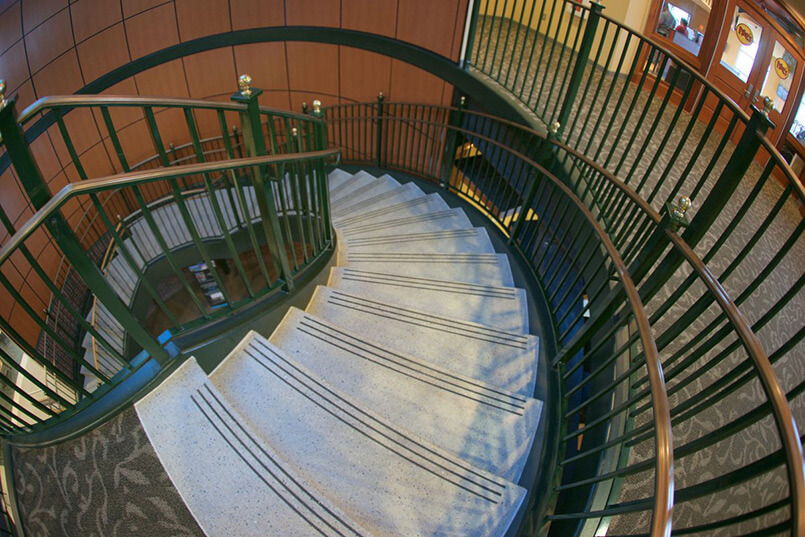
Precast and Different Terrazzo Matrices
Terrazzo is used in more ways than one on a given project. While terrazzo is commonly used as a flooring system, more designers are customizing terrazzo via precast form. Like the flooring system, precast can be manufactured in either a cement or epoxy matrix and retains the same qualities as its flooring counterpart. Precast terrazzo products are available in stairs, wall systems, wall base, countertops, tabletops, benches, tile, and other custom creations. When you think of it, an entire building can be covered in terrazzo.
When it comes to flooring, terrazzo is often poured in place and polished to smooth hard surfaces. There are several systems that fall into two matrices: cement or epoxy resin.
Epoxy terrazzo
Identified today as the most-installed system, you may have seen epoxy terrazzo in the main lobbies of corporate buildings, airports, and hospitals. This system is 1/4″ or 3/8″ in thickness. Despite its thin size, it actually is the most durable of the terrazzo systems and is recommended for use in high-traffic areas of buildings. It can be referred to thin-set or resinous terrazzo flooring.
It has advantages over cement-based systems. For example, the epoxy resins offer unlimited matrix colors, color control, resiliency, and greater tensile and compressive strengths. Due to its lightweight, it is also more flexible to use and is appealing for multistory buildings. From a design standpoint, epoxy terrazzo offers endless possibilities. It gives architects and interior designers a canvas to create any floor design to their liking.
From a construction standpoint, installers can turn over a project featuring epoxy terrazzo much quicker than cement terrazzo. It can be applied to prepared surfaces including concrete and plywood. The only drawback is that it is not recommended for use in outdoor applications. For indoor applications, it is highly recommended.
Cement terrazzo
Cement systems are thicker and heavier than epoxy terrazzo. According to the NTMA, sand cushion terrazzo is regarded as the best cement system available. Intended for indoor use, a 1/2″ inch cement matrix topping is used with a 2 1/2″ to 3-inch under bed of low-slump sand cement. The system includes wire reinforcing, isolation sheet, and sand-dusting layer over the concrete slab. Other cement systems are available as well including monolithic, bonded, and polyacrylate terrazzo. For outdoor applications, rustic terrazzo is recommended. This is a textured system that is weather and skid-resistant commonly used along with patios and walkways to entrance buildings.
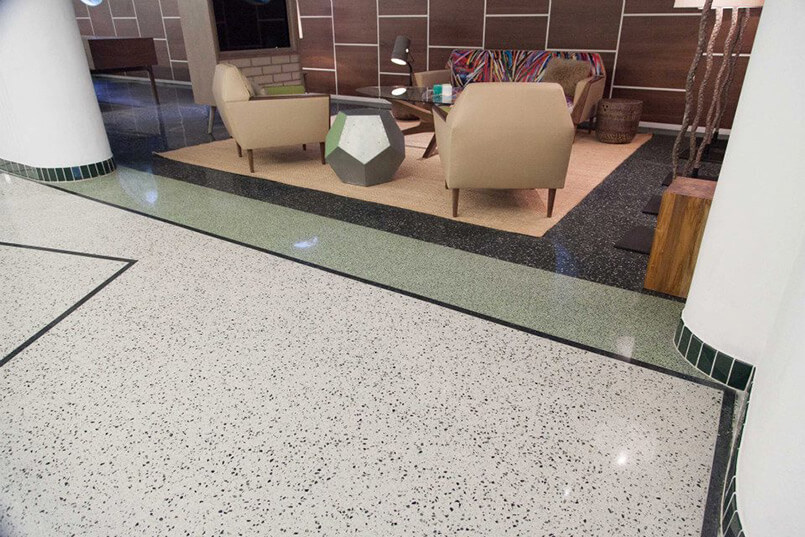
Renovating with Terrazzo
Now that we’ve covered the history and terrazzo systems, we’ll discuss how terrazzo can benefit existing buildings before exploring sustainable and design options.
Epoxy terrazzo has been specified across many building sectors in the United States. It can even be applied to existing buildings. One common issue buildings face is the need to repair or replace their flooring system after a number of years. With epoxy terrazzo, the floor is built to last and is simple to take care of after installation. Epoxy colors remain consistent and do not fade through the years. In recent news, older buildings are now finding terrazzo beneath a worn-out carpet, which can be restored to its original appearance. We’ll explain two scenarios: 1) how to add new terrazzo to renovated buildings and 2) how to restore existing terrazzo.
Adding Epoxy Terrazzo to Renovations
As mentioned, epoxy terrazzo can be poured over existing floors. In these situations, the existing floor does not have to be demolished and removed. By avoiding the need to take apart the existing floor, building owners can save on time and costs to upgrade to a new flooring system.
Epoxy terrazzo can be applied over any substrate that is sound and secure. It is important that before any work begins, that the substrate is cleaned and approved as structurally sound. If so, this will create a better bond between the existing floor and the terrazzo topping. If the floor is not in the right conditions, the existing floor must be repaired, removed, or replaced. Also, always test moisture levels when considering epoxy terrazzo. A great solution is to add a moisture mitigation system. Moisture mitigation systems control the vapor transmissions in order to secure the bond between the terrazzo and an existing floor.
Rule of thumb: Terrazzo should not be applied over soft materials. Soft materials include carpet, vinyl tile, and cork. Some acceptable systems to replace terrazzo with include concrete, polished concrete, brick pavers, and plywood. Speak with a terrazzo installer to consider your options.
Restoring Terrazzo
Terrazzo can be restored in existing buildings. With proper maintenance, terrazzo can look as good as new for many years. Sometimes when terrazzo floors need repairs or refinishing, it can be completed at little cost to the building owner. Contractors will inspect the terrazzo floor and return the floor to its original shine and color. It will appear as though the floor had never lost its touch.
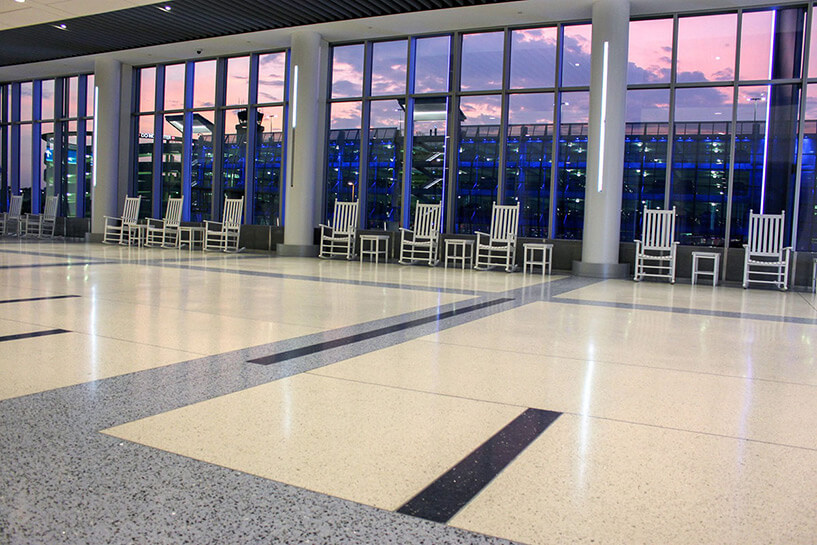
Why New Buildings and Renovations Consider Epoxy Terrazzo?
Performance. There are many durable flooring systems architects can review for their building space but none of them can match the long-term performance and aesthetics of an epoxy terrazzo floor. If well-maintained, an epoxy terrazzo floor will look amazing decades from now. Older buildings have documented how well terrazzo stands up against the test of time. The timeless floor can take on daily foot traffic for years or uphold well against natural disasters such as hurricanes, tornados, and floods.
Terrazzo does well due to the following reasons:
-
Epoxy resins: After epoxies were introduced in the 1970s, terrazzo evolved to be much thinner and stronger than ever before. When poured in place, the epoxy binds together to form a seamless surface. Compared to cement systems, epoxy terrazzo showed greater advantages in regards to overall compressive and tensile strengths, color control, resiliency, and stain and chemical resistance.
-
Lightweight: At 3/8″ or 1/4″ thickness, epoxy terrazzo is incredibly thin compared to other flooring systems, yet it is the most durable. Thinset epoxy terrazzo is lighter in weight making it suitable for use in multi-story buildings or elevator cabs. The strength of the system performs well even in the most demanding spaces.
-
Low Maintenance: Taking action to clean terrazzo regularly will keep the surface well-maintained for decades. Cleaning a terrazzo floor is quick to complete, and will remove dirt and debris tracked into the building with ease.
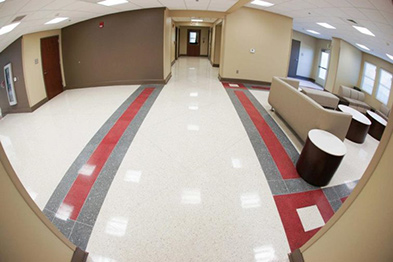
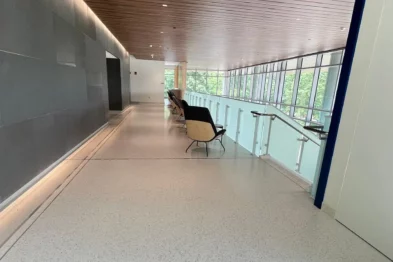
Sustainable Terrazzo
When designing terrazzo for new construction and existing buildings, sustainability comes into play.
Terrazzo is referred to as the original “green” flooring system for a reason. The method of reusing materials still lives on today. Terrazzo meets today’s sustainability needs addressing the following:
Zero VOC Materials and Antimicrobial Products
Our health is at the forefront of many changes in the architectural and construction world. The efforts to fight infection and build healthier environments can be accomplished by using the right set of building materials. Epoxy terrazzo addresses these efforts. Epoxy resin manufacturers like TERRAZZCO offer an antimicrobial additive to their products that do not allow bacteria to grow and spread. In addition to the antimicrobial component, epoxy resins are now tested annually to demonstrate the zero VOC contents it contains. Zero VOCs provide better indoor air quality absent of chemical emissions. TERRAZZCO Epoxy resins are GREENGUARD Gold certified and ideal for use in green building designs.
Responsible Aggregates
Epoxy terrazzo offers a wider selection of aggregates. These aggregates can consist of recycled post-industrial and post-consumer glass and stone materials, that conserve the Earth’s resources. Plastics and other synthetic materials have been tested for use.
Long Lifecycles
Ideal for areas with heavy foot traffic, terrazzo is a durable surface with high compressive and tensile strengths. The floor can withstand heavy use on a daily basis. With proper care, a terrazzo floor can last as long as the building structure.
Ease of Maintenance
Routine cleaning will keep the terrazzo well-maintained. Daily mopping using warm water or a neutral cleaner will suffice. Flooring systems like carpet use more energy through vacuuming and frequently require needed repairs and replacements during its lifecycle.
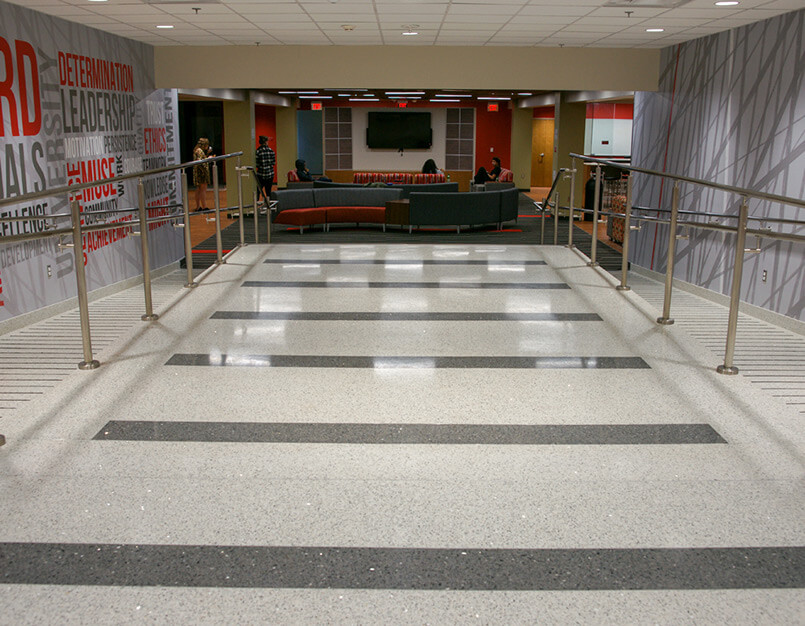
Green Building Credits
LEED v.4 criteria is examined when selecting building materials. The performance and properties of epoxy terrazzo meet today’s standards for green building design:
Material Resource
Both the epoxy resin and aggregates used in a terrazzo floor have great environmental implications for any building project. First, aggregates can be recycled and reused in terrazzo. Glass chips in particular often come from post-industrial and post-consumer sources. Aggregates are often sourced locally which reduces the carbon footprint via transportation.
Next, epoxy resins are 100% solids. TERRAZZCO Brand Products uses the highest amount of recycled and zero VOC materials in its composition, made from fumed silica and waste filler powders from the glass and mineral industry. When architects and designers specify epoxy terrazzo, they are selecting a flooring system that lasts. The durability and longevity of terrazzo are well accounted for over the decades. Other flooring systems will likely need to be replaced. Terrazzo will not.
Indoor Air Quality
Epoxy terrazzo using TERRAZZCO Brand Products contains zero VOCs. This means that no off-gassing will occur during the installation and after the floor has been completed. That’s great news for buildings looking to use healthier building materials. Paints and coatings today undergo yearly testing to determine their levels of VOC content. When you see a GREENGUARD label, you can rest assured the product is suitable for use for LEED projects. Using epoxy terrazzo in schools, hospitals and other public settings improves the overall indoor air quality and has no negative health risks among building occupants.
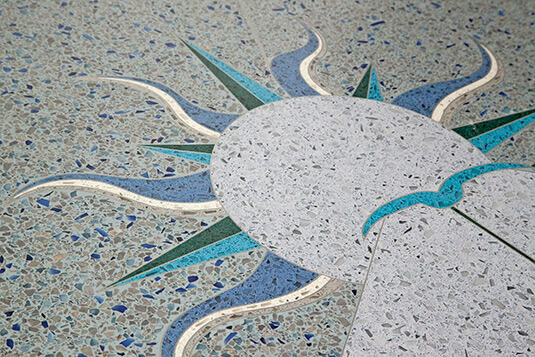
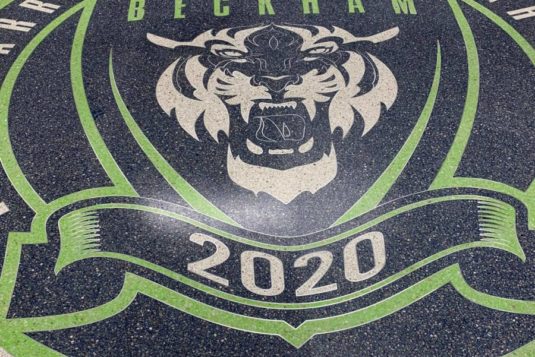
Designing New Terrazzo Floors
Now that we’ve covered the performance side of terrazzo floors. We will explore some of the design options available for epoxy terrazzo. The key thing to know about designing terrazzo is that you can truly create any floor that fits your project’s needs. The design possibilities are endless. This makes epoxy terrazzo an attractive flooring choice to work with on building projects.
The Versatility of Terrazzo
Architects can enjoy the wide range of customization that terrazzo offers. There’s so much one can do with the building materials. Commonly used as a flooring system, terrazzo can also be used throughout a building space including countertops, wall systems, stairs, wall base, tabletops, and other hard surface finishes.
What’s great about the building material is that it allows virtually any color and pattern to be incorporated into the floor design. Epoxy resins can be formulated to match light, dark and vibrant colors. More so, imagery such as brand logos, maps, government seals, numbers and letters, and other artistic works can be created.
There are also other material options to consider. In contrast to cement terrazzo, epoxy terrazzo offers a wider selection of aggregates. Marble chips are classic. But today you can also include recycled options such as glass, porcelain or concrete, Mother of Pearl, and synthetic chips. Divider strips, which form the layout of the floor design and help support the surface from cracking, are available in different materials. Aluminum and zinc are commonly used, but architects have options to select brass divider strips or plastic divider strips as well.
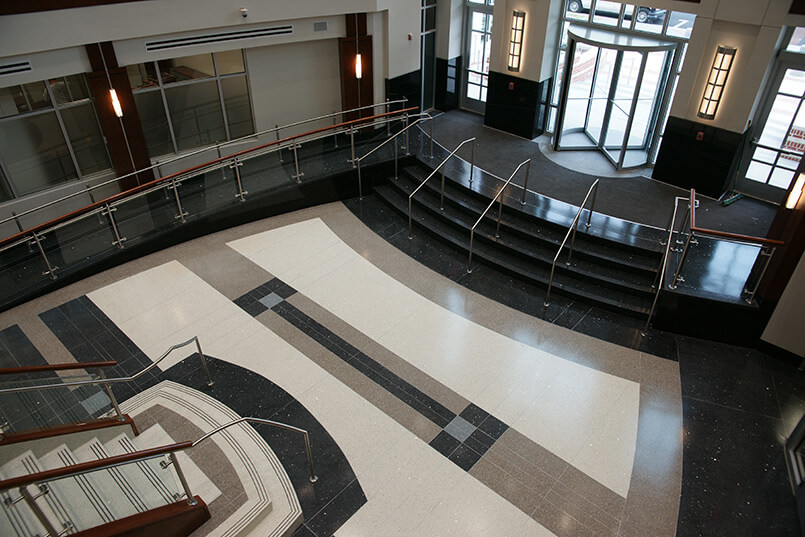
Should You Consider Epoxy Terrazzo For Your Building Project?
Epoxy terrazzo offers many advantages over other flooring systems including a long lifecycle, design flexibility, and use of sustainable materials. Terrazzo is a great commercial flooring solution yet the cost of the product is often discussed. While there is a higher initial cost associated with terrazzo, the flooring system actually has the lowest flooring lifecycle cost. This bodes well for buildings that will operate for multiple decades or experience heavy foot traffic daily.
For architects looking to find ways to manage the cost of terrazzo for their building projects, here are some tips to consider:
-
Design: When designing a terrazzo floor, a couple of tweaks to your design can factor into the overall cost. First, consider the number of colors. Regardless of the design, terrazzo will last the lifetime of the building. So selecting 1 or 2 colors to plan your design will fare well better than selecting several colors. Custom designs such as logos and seals can be omitted to meet budget constraints. Also, consider your floor plan. In areas where people tend to gather, it might be a great idea to add a logo or customize the floor design in a more creative way. However, for places like office rooms, break rooms, or the least visited areas of a building, consider keeping the terrazzo design simple.
-
Aggregates: Not all aggregates are created equal. Marble chips are commonly used in the majority of today’s installations; however, Mother of Pearl and glass chips can increase costs. Size matters too. For architects looking to do a Venetian terrazzo or Palladiana floor, expect a premium price for those styles. Even the smallest aggregates may be subject to higher material costs due to the time and labor necessary to convert terrazzo chips to the finest sizes. Our recommendation is to consider selecting standard-size chips for your terrazzo installation. These are graded at sizes 0 to 2.
-
Divider Strips: Aluminum divider strips are widely used and affordable. Zinc and brass divider strips cost more.
-
Cost for Labor: The NTMA recommends hiring a professional terrazzo contractor to perform the installation. Epoxy terrazzo is the quickest terrazzo system to complete. Once poured, epoxy terrazzo can be cured overnight and walked on the next day. Epoxy terrazzo is completed by grinding, polishing, and sealing the floor. Cement systems will take longer to complete thus may increase labor costs.
-
Poured in Place vs Tile: The price per square footage for poured in place terrazzo installations include the cost of labor and materials. Tile can be manufactured offsite and installed by a flooring contractor, but costs may vary depending on which manufacturer and installer you choose. It is best to contact a terrazzo-approved contractor to understand installation costs and lead times for materials.
-
Initial Costs: When reviewing durable flooring options for commercial applications, epoxy terrazzo is comparable in cost with better performance and design flexibility.
-
Maintenance Costs: Consider possible repair and replacement costs as well as cleaning costs. When reviewing commercial flooring options, epoxy terrazzo is favorable and yields cost savings for building owners.
Conclusion
We believe architects, interior designers, and building owners can find use for terrazzo in their building projects. The durability, ease of maintenance, and design flexibility of the building material is well documented over the years, and have turned out some of the most beautifully-designed spaces ever made. Generally speaking, we’ve seen terrazzo emerge as a popular material due to its contributions to LEED points and green building goals. And while terrazzo has been used often as a flooring system, it continues to evolve. The customization of terrazzo presents designers with ways to form unique products for their building spaces. New technologies and product research will continue to support epoxy terrazzo as the premier flooring of choice for new construction and renovation projects. 100 years have passed since terrazzo first arrived in the United States, and remains a cost-effective flooring option to this day.
If you have questions about how terrazzo can benefit your next flooring project, our representatives are available to assist you. Contact a Concord Terrazzo Company representative today at info@terrazzco.com.






